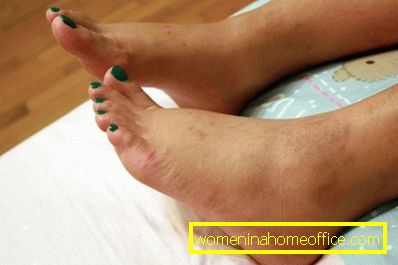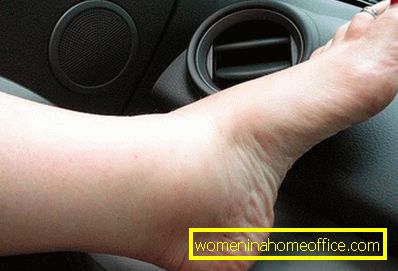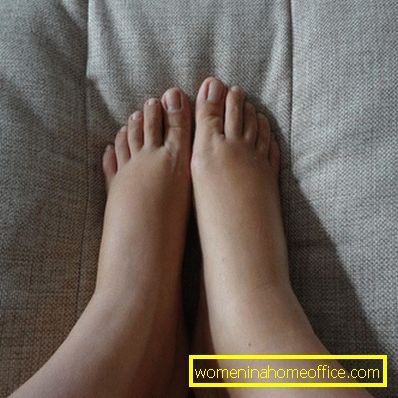Feet swell in the ankles
Almost every person faces swelling of the legs in the ankle area. Most often, this problem overtakes women who wear high-heeled shoes. Sometimes the swelling of the legs can be caused by constant tension of the foot when walking, resulting in fluid accumulation near the ankle. Puffiness can appear on both legs equally. The main thing is to identify the cause in time and eliminate it.
In this article, you will learn about the main causes of ankle edema, precautions and treatment.
What are the causes of swelling of the legs in the ankle?

Experts in the field of medicine have come to the common opinion that swelling in the legs in the ankle area can have various reasons. There are swelling of these types:
- unilateral;
- bilateral.
Unilateral edema
Unilateral edema is manifested in the formation of swelling as a result of fluid accumulation on one of the legs. Swelling occurs on one side of the ankle. Fluid accumulation in this area can trigger:
- injury;
- the development of thrombosis;
- infectious pathogens;
- the development of the inflammatory process;
- insect bites;
- phlebeurysm.
Lower limb injury
Swelling near the ankle occurs in case of injury to the joints, bones or ligaments. With a closed type of bone fracture in the ankle, there is a sharp pain syndrome and swelling, which in this case is due to the accumulation of blood flowing from the damaged blood vessels.

Thrombosis development
Also, the ankle may swell as a result of blockage of blood vessels. Thrombosis occurs when a blood clot forms in a vessel. This indicates a violation of blood circulation. The vessel may be completely clogged or narrowed. A person experiences pain, edema appears. Along with the formation of blood clots, an inflammatory process may develop in the veins, called thrombophlebitis.

Development of an infectious disease
An infection in the open wound on the leg, especially in the ankle area, can provoke the last edema. Infectious pathogens cause the development of the inflammatory process. Edema can occur in the presence of certain skin diseases or in the development of abscesses and phlegmon.
Inflammatory process
The development of the inflammatory process caused by a disease, for example, arthrosis or arthritis, may result in the appearance of ankle edema. The accumulation of fluid is not associated with inflammation, but with a change in load or its improper distribution on the articular tissue.
Puffiness with various bites
Often, swelling in the ankle area can occur as a result of an amphibian bite or insect bite. When they bite, they release a toxic substance that gets under the skin and causes the development of an inflammatory process. In most cases, the swelling may be due to an allergic reaction to the bite.

Phlebeurysm
Varicose veins often appear in women. The emergence of this disease contributes to a variety of causes and factors. As a result of venous insufficiency, an edema appears in the ankle area. The development of edema indicates a violation of the functioning of the valvular apparatus and the fact that blood moves to the heart unsuitably. In the veins, blood stagnation occurs, and the surrounding fluid begins to soak into other tissue and interstitial layers, resulting in the formation of edema.

Bilateral puffiness
Bilateral edema around the ankle occurs on both legs. This phenomenon may be due to the following reasons:
- long standing;
- wearing uncomfortable shoes;
- obesity;
- pregnancy;
- the development of kidney or heart disease;
- pathology of lymphatic drainage from the legs (lymphedema or lymphostasis);
- taking pharmacological drugs of various spectra of action.
Long standing
If a person has been in one static position for a long time, for example, he is sitting or standing, then swelling in the area of the ankle may be observed due to a temporary disturbance of lymph outflow. Therefore, when your lifestyle is associated with sitting work or standing, for example, at the bench or some equipment, periodically you need to change the static posture and give your legs the opportunity to relax.

Wearing everyday discomfort shoes
Shoes should be beautiful and comfortable. This is especially true for casual shoes. Women like to wear high-heeled shoes, often the shoe itself can be uncomfortable and over time bring discomfort. Prolonged finding of the foot in an unnatural (wrong) position can cause swelling. Puffiness may also occur after playing sports. If you are wearing uncomfortable sports shoes, the outflow of blood and lymph is disturbed, resulting in swelling in the ankle area.

Swelling of the legs with excess weight
If a person is overweight or is obese of varying degrees, the appearance of edema in the ankle area is quite natural. There is excessive pressure on the joints, the circulation of fluid and blood is disturbed.

Edema during pregnancy
During gestation, puffiness in the ankle area may appear in the third trimester, closer to the delivery process. This is due to the fact that the reproductive organ squeezes the genital vein, so blood circulation and fluid outflow are disturbed.
Onset of leg edema in renal and cardiovascular diseases
Water balance is disturbed as a result of kidney failure. The permeability of the walls of blood vessels increases, and therefore non-withdrawn fluid accumulates between the tissues. Increased blood pressure can cause swelling in the ankle area. Most often, such a manifestation occurs in the afternoon.
Pathology of lymph drainage
In identifying diseases associated with impaired lymphatic outflow, a concomitant symptom is the formation of edema. Lymph accumulates in the tissues and between them, resulting in the formation of swelling in the ankles and lower legs.
Often, long-term use of pharmacological drugs belonging to the hormonal, hypotensive group, or antidepressants can cause fluid accumulation in the tissue layers, resulting in swelling in the ankle area.
What should I do if my ankle leg swells?

If you began to notice that your legs, especially in the ankle, are swollen, then you need to contact your doctor. If this is due to sprains, joint damage, dislocation or fracture, you should immediately go to a traumatologist. If edema is associated with mechanical damage to the leg, then you should contact the therapist, who will conduct a full-scale examination and be able to identify the cause of this phenomenon.
Depending on the cause of puffiness, the attending specialist will prescribe an individual treatment course. It is not recommended to start diuretic pharmacological or folk remedies without prior consultation with a specialist. It can only cause aggravation and aggravate the disease.
Asli leg swelling is not due to the development of any disease?
If the legs in the ankle area swell constantly, but this is not associated with the development of a serious disease, but is caused by wearing uncomfortable shoes, pregnancy or overweight, the doctors recommend taking the following measures on their own:
- in the evening, rest in a prone position, raising your legs above your head;
- drink less fluids;
- limit the amount of salty food intake;
- take a shower (preferably a contrast);
- periodically make saline baths;
- try changing your shoes;
- perform physical therapy exercises;
- take a course of massage treatments;
- follow a diet for weight loss.
The appearance of swelling of the legs may be due to various reasons. Be sure to pass a full examination. If swelling occurs as a result of the development of serious pathologies, the doctor will prescribe a treatment course with pharmacological agents. Remember, women often have puffiness due to wearing uncomfortable shoes.